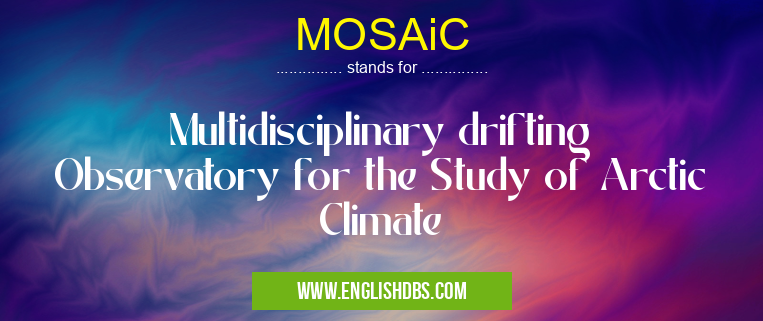What does MOSAIC mean in RESEARCH
MOSAiC stands for Multidisciplinary drifting Observatory for the Study of Arctic Climate. It is a year-long scientific expedition that will take place in the Arctic Ocean from September 2019 to October 2020. The expedition will involve over 600 scientists from 20 countries who will study the Arctic climate system, including the atmosphere, ocean, sea ice, and ecosystem.

MOSAiC meaning in Research in Academic & Science
MOSAiC mostly used in an acronym Research in Category Academic & Science that means Multidisciplinary drifting Observatory for the Study of Arctic Climate
Shorthand: MOSAiC,
Full Form: Multidisciplinary drifting Observatory for the Study of Arctic Climate
For more information of "Multidisciplinary drifting Observatory for the Study of Arctic Climate", see the section below.
Purpose of MOSAiC
The main goal of MOSAiC is to improve our understanding of the Arctic climate system and its role in global climate change. The expedition will collect data on a variety of climate variables, including temperature, wind speed, humidity, and sea ice thickness. This data will be used to develop new models of the Arctic climate system and to improve our ability to predict future climate change.
Methods
The MOSAiC expedition will use a variety of methods to collect data on the Arctic climate system. These methods include:
- Atmospheric measurements: Scientists will use instruments mounted on the research vessel Polarstern to measure atmospheric variables such as temperature, wind speed, and humidity.
- Oceanographic measurements: Scientists will use instruments deployed in the ocean to measure oceanographic variables such as temperature, salinity, and currents.
- Sea ice measurements: Scientists will use instruments deployed on the sea ice to measure sea ice thickness, temperature, and salinity.
- Ecosystem measurements: Scientists will study the Arctic ecosystem, including the distribution and abundance of plants and animals.
Significance of MOSAiC
The MOSAiC expedition is a significant scientific undertaking that will provide valuable data on the Arctic climate system. This data will be used to improve our understanding of the Arctic climate system and its role in global climate change. The expedition will also help us to develop new adaptation and mitigation strategies for climate change.
Essential Questions and Answers on Multidisciplinary drifting Observatory for the Study of Arctic Climate in "SCIENCE»RESEARCH"
What is MOSAiC?
MOSAiC is a year-long international research expedition that began in September 2019. The expedition involves a team of scientists from over 20 countries who are studying the Arctic climate and environment. The expedition is based on the German research vessel Polarstern, which is frozen into the Arctic sea ice.
What are the goals of MOSAiC?
The goals of MOSAiC are to:
- Improve our understanding of the Arctic climate system.
- Advance our ability to predict Arctic climate change.
- Provide important data for climate models.
- Raise awareness of the importance of the Arctic.
What is the significance of MOSAiC?
MOSAiC is significant because it is the first year-long expedition to be conducted in the central Arctic. The data collected during the expedition will help scientists to better understand the Arctic climate system and its role in global climate change.
What are the challenges of conducting research in the Arctic?
There are a number of challenges to conducting research in the Arctic, including:
- The extreme cold and darkness of the winter months.
- The lack of infrastructure and support.
- The presence of sea ice and icebergs.
- The logistical challenges of transporting equipment and personnel.
How is MOSAiC funded?
MOSAiC is funded by a consortium of national funding agencies, including the German Federal Ministry of Education and Research, the European Commission, and the National Science Foundation.
Final Words: The MOSAiC expedition is a groundbreaking scientific undertaking that will provide valuable data on the Arctic climate system. This data will be used to improve our understanding of the Arctic climate system and its role in global climate change. The expedition will also help us to develop new adaptation and mitigation strategies for climate change.
MOSAiC also stands for: |
|
| All stands for MOSAIC |
